Though the Bible does not use the word Volcano, there are passages that refer to volcanic activity. I am certain that the fact that there are increasing numbers of Volcanic Eruptions at increasing levels of intensity and magnitude, is more evidence of the times we are living.
Most people are probably not aware of just how active the world’s volcanoes are becoming. This posts includes some of the most recent events, it is certainly not an all inclusive update. The point is to make people aware of what is happening.
Also included in the post is information on what Science is doing in the area of Volcanic Activity. This will include documentation of their efforts to control Volcanoes, employ them for Climate Control as well as population control.
There is also some information on a new phenomenon…at least new to me. Something I learned today. I am not yet certain how much it applies to the agenda, but it is an interesting little study.
I hope you find this information helpful. It is not intended to instill fear. Remember that GOD is in CONTROL. We are not to fear, but respond to everything from a place of strength, courage and FAITH.
Update March 11
spacer
![]()
class=”style-scope ytd-video-primary-info-renderer”>
DEUTERONOMY 4:11 In the Bible Verse Meaning
-
11 And ye came near and stood under the mountain; and the mountain burned with fire unto the midst of heaven, with darkness, clouds, and thick darkness.
DEUTERONOMY 5:23 In the Bible Verse Meaning
-
23 And it came to pass, when ye heard the voice out of the midst of the darkness, (for the mountain did burn with fire,) that ye came near unto me, even all the heads of your tribes, and your elders;
JUDGES 5:5 In the Bible Verse Meaning
-
5 The mountains melted from before the LORD, even that Sinai from before the LORD God of Israel.
PSALM 97:5In the BibleVerse Meaning
-
5 The hills melted like wax at the presence of the LORD, at the presence of the Lord of the whole earth.
PSALM 104:32 In the Bible Verse Meaning
-
32 He looketh on the earth, and it trembleth: he toucheth the hills, and they smoke.
PSALM 144:5 In the Bible Verse Meaning
-
5 Bow thy heavens, O LORD, and come down: touch the mountains, and they shall smoke.
ISAIAH 34:9,10 Verses in the Bible
-
9 And the streams thereof shall be turned into pitch, and the dust thereof into brimstone, and the land thereof shall become burning pitch.
-
10 It shall not be quenched night nor day; the smoke thereof shall go up for ever: from generation to generation it shall lie waste; none shall pass through it for ever and ever.
ISAIAH 64:1-3 Verses in the Bible
-
1 Oh that thou wouldest rend the heavens, that thou wouldest come down, that the mountains might flow down at thy presence,
-
2 As when the melting fire burneth, the fire causeth the waters to boil, to make thy name known to thine adversaries, that the nations may tremble at thy presence!
-
3 When thou didst terrible things which we looked not for, thou camest down, the mountains flowed down at thy presence.
JEREMIAH 51:25 In the Bible Verse Meaning
-
25 Behold, I am against thee, O destroying mountain, saith the LORD, which destroyest all the earth: and I will stretch out mine hand upon thee, and roll thee down from the rocks, and will make thee a burnt mountain.
MICAH 1:4 In the Bible Verse Meaning
-
4 And the mountains shall be molten under him, and the valleys shall be cleft, as wax before the fire, and as the waters that are poured down a steep place.
NAHUM 1:5,6 Verses in the Bible
-
5 The mountains quake at him, and the hills melt, and the earth is burned at his presence, yea, the world, and all that dwell therein.
-
6 Who can stand before his indignation? and who can abide in the fierceness of his anger? his fury is poured out like fire, and the rocks are thrown down by him.
spacer
Here is a good source for updates on Volcanoes
Volcano Updates – USGS
<“https://www.youtube.com/channel/UCniIvueCmWtz_3iq2A-uTfw”>Morning D.E.W.
spacer
spacer
“https://www.youtube.com/channel/UC2mtXUpAYLYJIZ2deSPhlqw”>
“https://www.youtube.com/channel/UC2mtXUpAYLYJIZ2deSPhlqw”>RT in Spanish
spacer
Gravitas: Iceland prepares for a volcanic eruption
Mar 9, 2021
ERUPTION! Taal is awake! Phillipines on alert! Evacuation possible!
spacer
https://www.youtube.com/channel/UCYeGh5VML5XPr5jYnzh3J6g”>GeologyHub
Alert Level Raised After Explosion at Remote Alaska Volcano
Officials at the Alaska Volcano Observatory have raised the alert level after a small explosion was recorded at a remote volcano. By Associated Press , Wire Service Content March 4, 2021
ANCHORAGE, ALASKA (AP) — A small explosion was recorded Thursday at a remote volcano on the Alaska Peninsula, prompting officials to raise the alert level.
Satellite and webcam views indicated low-level ash emissions from Mount Veniaminof volcano. The ash plume did not rise above 10,000 feet (3048 meters), the Alaska Volcano Observatory said. Minor ash deposits are visible at the volcano, located 480 miles (772 kilometers) southwest of Anchorage.
Veniaminof is one of the most active volcanos in the Aleutians, erupting at least 14 times in the last 200 years.
The stratovolcano located in the Alaska Peninsula National Wildlife Refuge is usually shrouded in fog and clouds, and the entire volcano is usually only visible once or twice a year, the park service said.
Mount Veniaminof, with an elevation of 8,225 feet (2,507 meters), has an ice field of 25 square miles (64.75 square kilometers). The park service says it’s the only known glacier on the North American continent with an active volcanic vent in the center.
Copyright 2021 The Associated Press. All rights reserved. This material may not be published, broadcast, rewritten or redistributed.
spacer

ANCHORAGE, ALASKA (AP) — A small explosion was recorded Thursday at a remote volcano on the Alaska Peninsula, prompting officials to raise the alert level.
Satellite and webcam views indicated low-level ash emissions from Mount Veniaminof volcano. The ash plume did not rise above 10,000 feet (3048 meters), the Alaska Volcano Observatory said. Minor ash deposits are visible at the volcano, located 480 miles (772 kilometers) southwest of Anchorage.
Mount Veniaminof (center right) with ashy eruption plume, seen from Perryville on March 4, 2021. (Alaska Volcano Observatory capture from the FAA Perryville NW webcam)
A small explosion was detected at the Mount Veniaminof volcano early Thursday morning. Veniaminof is on the Alaska Peninsula, north of Perryville.
Satellite and webcam footage revealed small deposits of ash near the summit. The ash cloud stayed below 10,000 feet.
Below: Aerial view of Mount Veniaminof summit cone and 2018 lava flow. (Alaska Volcano Observatory)
 The Alaska Volcano Observatory raised the aviation color code to orange to warn pilots in the area of possible ash emissions. Color code orange means there is heightened unrest at a volcano with an increased potential for eruption, but that the risk is limited.
The Alaska Volcano Observatory raised the aviation color code to orange to warn pilots in the area of possible ash emissions. Color code orange means there is heightened unrest at a volcano with an increased potential for eruption, but that the risk is limited.
Geologists observed sulfur in the area over the past few days and a rise in surface temperature Wednesday night.
Ash emissions and lava spray and flow are typical for Veniaminof. Ash usually stays contained in the summit crater but can occasionally fall in nearby areas. A satellite link at Port Heiden is out, so local seismic activity is offline at this time. The volcano observatory continues to monitor the situation.
Veniaminof is one of the most active volcanos in the Aleutians, erupting at least 14 times in the last 200 years.
The stratovolcano located in the Alaska Peninsula National Wildlife Refuge is usually shrouded in fog and clouds, and the entire volcano is usually only visible once or twice a year, the park service said.
Mount Veniaminof, with an elevation of 8,225 feet (2,507 meters), has an ice field of 25 square miles (64.75 square kilometers). The park service says it’s the only known glacier on the North American continent with an active volcanic vent in the center.
Copyright 2021 The Associated Press. All rights reserved. This material may not be published, broadcast, rewritten or redistributed.
(WATCH) Fearsome Volcano Eruption | Sharyl Attkisson
To Watch this Video on UGETube: Click Here

spacer
Mount Etna, Europe’s most active volcano, erupts seven …
Spectacular Mount Etna eruptions in February 2021 in …
Sakurajima volcano in Japan erupts powerfully in February 2021
The explosive activity of Sakurajima volcano in Japan continues.
On February 10, the Volcanic Ash Advisory Center (VAAC) Tokyo warned about a volcanic ash plume that rose up to an estimated 7000 ft (2100 m) altitude or flight level 070 and is moving at 10 kts in E direction.
Look at the powerful explosion in the video below:
sp
Sakurajima volcano in Japan erupts powerfully video …
acer
Philippines: location of active volcanoes 2021 | Statista
USGS diagram illustrating the decrease in depth of Halemaʻumaʻu crater due to the 2020 summit eruption (Courtesy USGS Hawaiian Volcano Observatory). Click to view full-size.
Shortly after approximately 9:30 p.m. on Sunday, December 20, the USGS Hawaiian Volcano Observatory (HVO) detected glow within Halemaʻumaʻu crater at the summit of Kīlauea Volcano. The water lake that had existed at the summit of Kīlauea since 2019 soon boiled away as an effusive eruption commenced. Three initial vents in the wall of Halemaʻumaʻu crater cascaded lava flows into a growing lava lake on the crater floor.
As of March 4, the lava lake is more than 722 feet (220 m) deep and is partially stagnant. Note: molten lava is not visible from any publicly accessible areas, though its nighttime glow and plume may be visible from a distance. Below are select photographs and videos from the eruption, as it progresses.
For current monitoring info about Kīlauea, see: https://volcanoes.usgs.gov/volcanoes/kilauea/status.html
2020-2021 Summit Eruption
On December 20, 2020, lava cascaded into Halemaʻumaʻu crater and began to form a deep lava lake
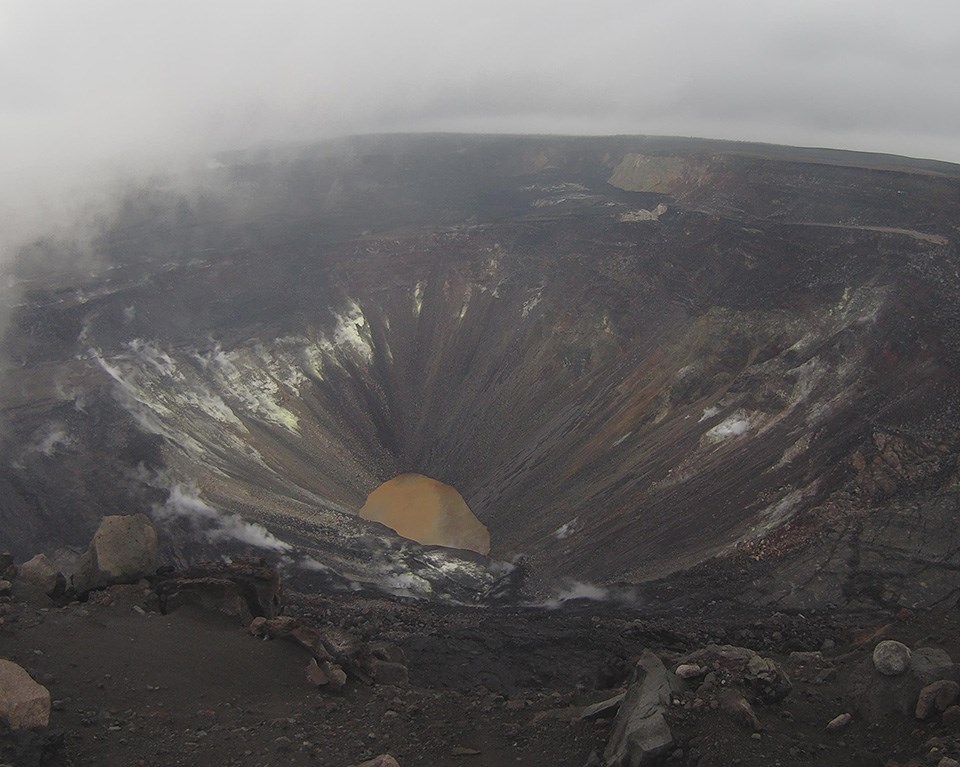
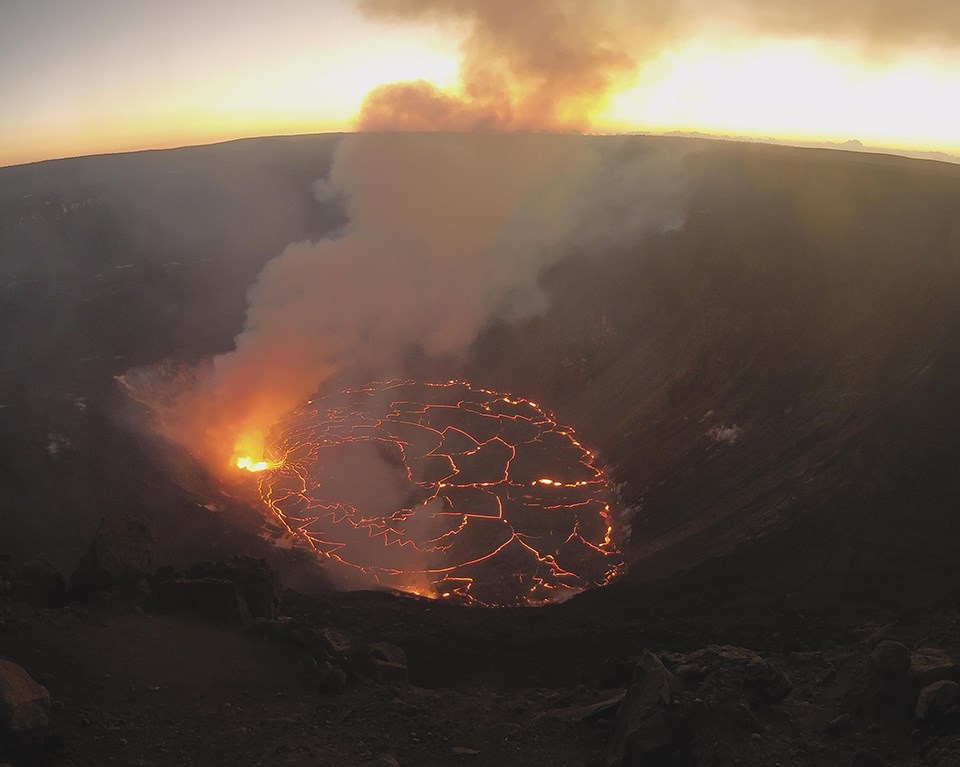
- DURATION:
- 1 minute, 38 seconds
The western vent feeding the lava lake in Halemaʻumaʻu became partially submerged in the first days of January. The result is a rolling upwelling of lava called a “dome fountain.” The height of the dome fountain was estimated to be about 16 feet (5 m) with an estimated width of 33 feet (10 m). Note: this telephoto image was taken by scientists studying the eruption and this view is not available from publicly accessible areas. Video by the USGS Hawaiian Volcano Observatory.
-

First Scenes of the 2020 Summit Eruption
An early moment in the 2020 summit eruption on December 20, 2020, as lava entered Halemaʻumaʻu crater and vaporized the large lake of water at the bottom. Video contains no audio. (NPS Video/J. Wei)
- DURATION:
- 51.568 seconds
-

Lava Cascades in Halemaʻumaʻu as Eruption Begins, December 20, 2020
Lava cascaded from the wall of Halemaʻumaʻu crater into a pool at the bottom, shortly after the summit eruption began on December 20, 2020. Video by the USGS Hawaiian Volcano Observatory.
- DURATION:
- 44.678 seconds
-

Saturn and Jupiter Over Erupting Halemaʻumaʻu
On Tuesday, December 22, the conjuction of Jupiter and Saturn was seen over the new eruption at the summit of Kīlauea. They can be seen in close proximity above the glowing plume emanating from Halemaʻumaʻu crater. Video contains no audio. (NPS Video/D. Hubner)
- DURATION:
- 21.855 seconds
-

Thermal Image of Island in Lava Lake
As of December 29, 2020 an island of volcanic material continues to float in the lava lake in Halemauʻumaʻu crater. In these timelapse images captured by the USGS Hawaiian Volcano Observatory over the course of 24 hours, the island wanders slightly on the lake’s surface. Clip is repeated several times.
- DURATION:
- 20.806 seconds
-

Sunrise Timelapse Near Kīlauea Overlook
A timelapse video in the lead up to sunrise on January 7, 2021, near Kīlauea Overlook. Video contains no audio. (NPS Video/J. Prugsawan)
- DURATION:
- 15.215 seconds
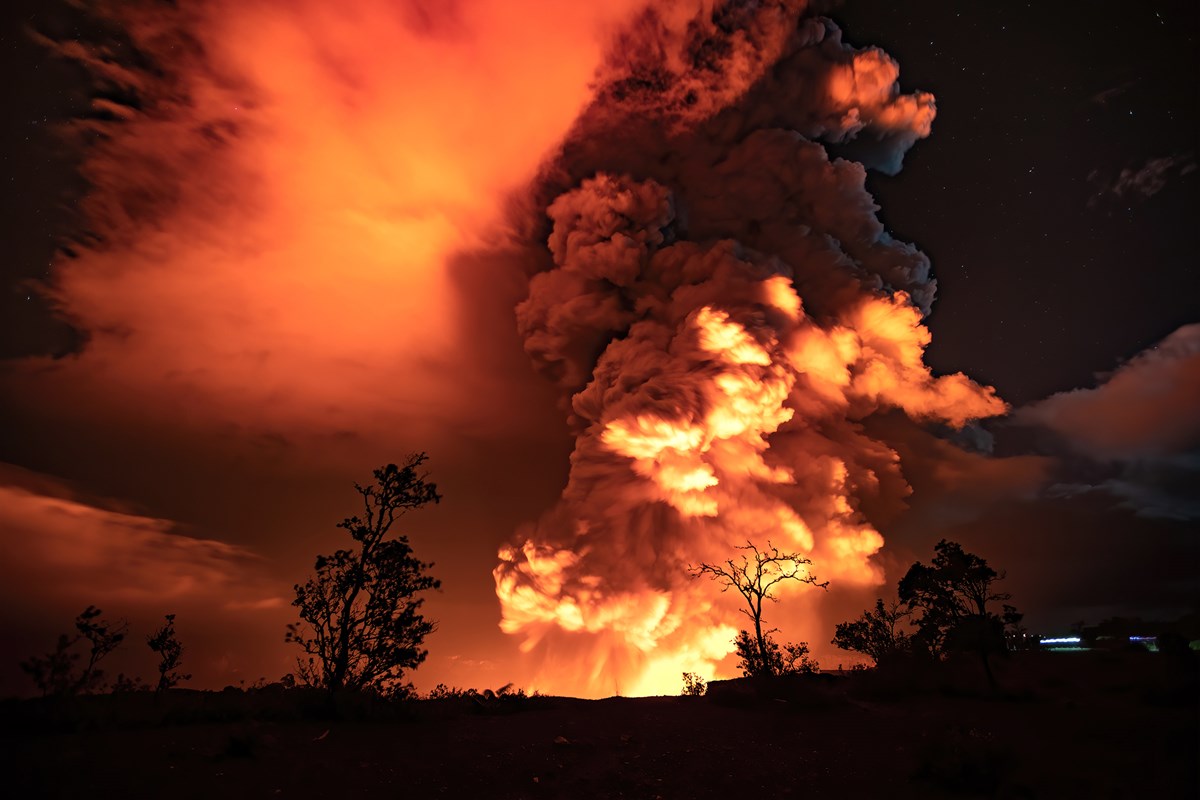
Halemaʻumaʻu at approximately 10:30 p.m. on December 20, shortly after the eruption began. (NPS Photo/J. Wei)
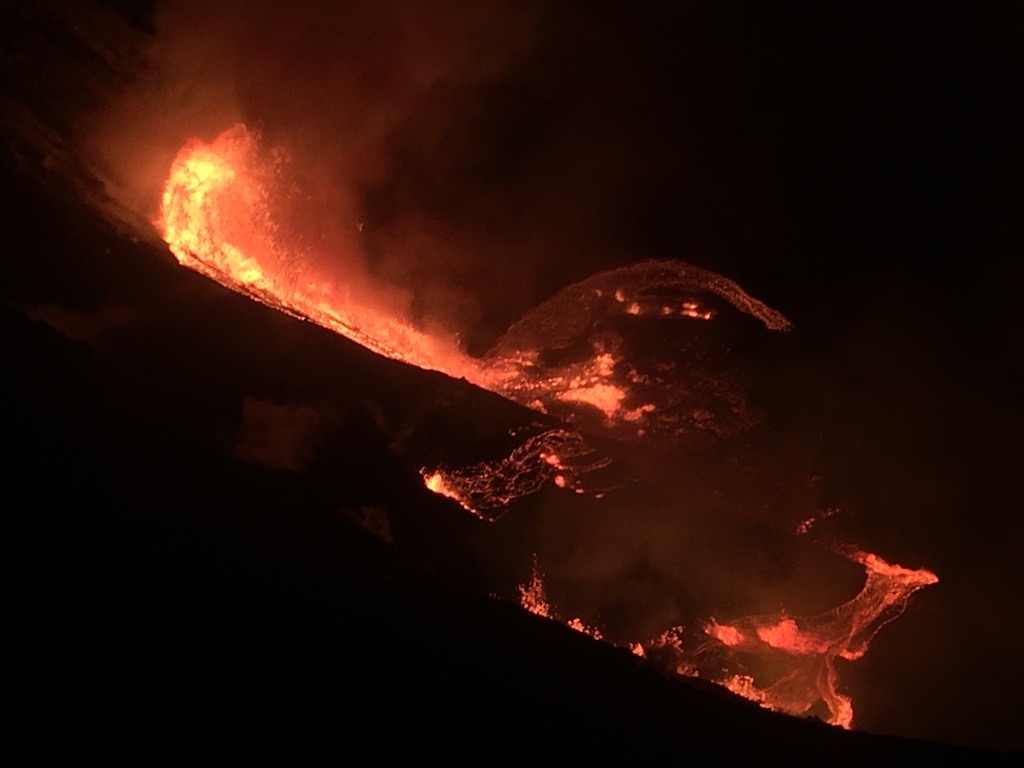
Lava cascading into the base of Halemaʻumaʻu shortly after the eruption began, December 20. Note: this photo was taken by scientists studying the eruption and this view is not available from publicly accessible areas. (USGS Photo)
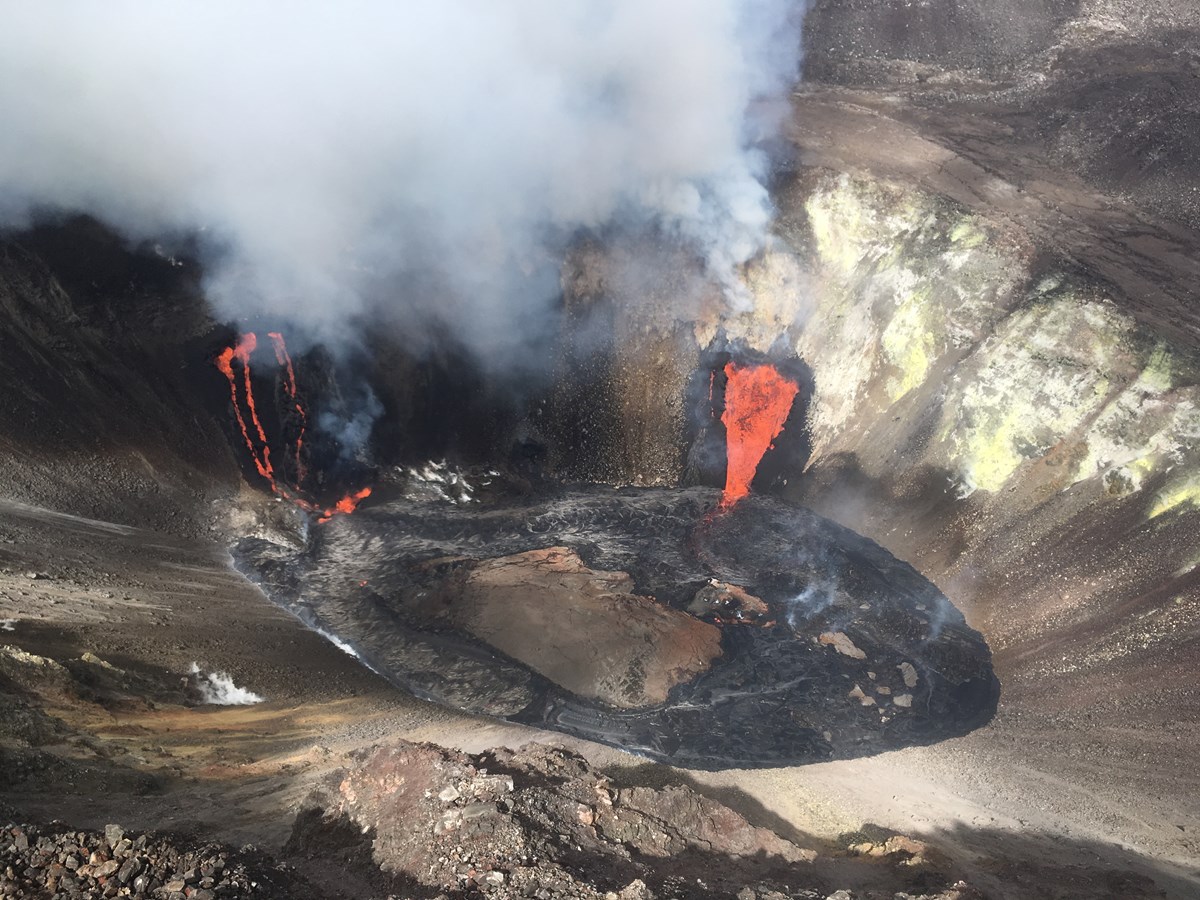
Note: this aerial photo was taken by scientists studying the eruption and this view is not available from publicly accessible areas (USGS Photo/M. Patrick)
As of 11:20 a.m. on December 21, two of the three original vents were still active, feeding the lava lake. The northern vent (right side) would soon be submerged.
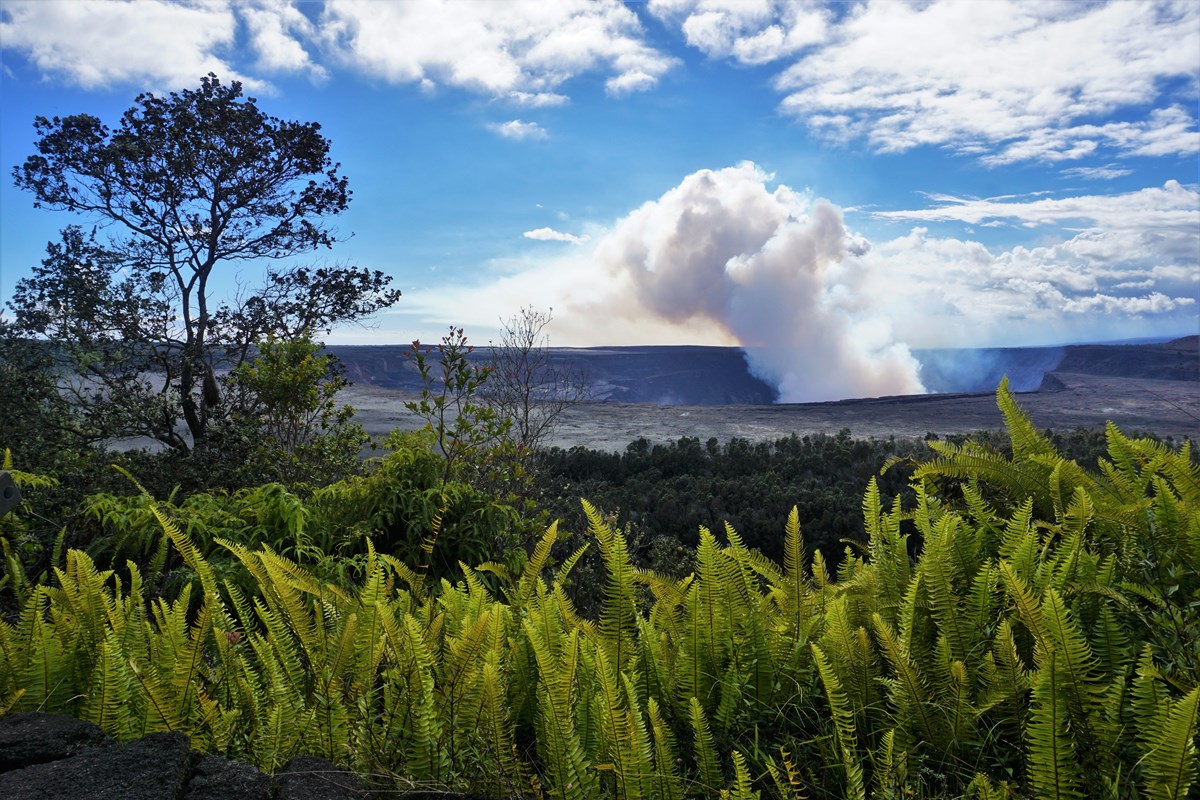
The view from Crater Rim Trail behind Volcano House, December 21 at approximately 2:30 p.m. (NPS Photo/A. LaValle)

View from Crater Rim Trail approaching Kīlauea Overlook, December 22, 2020 (NPS Photo/A. LaValle)

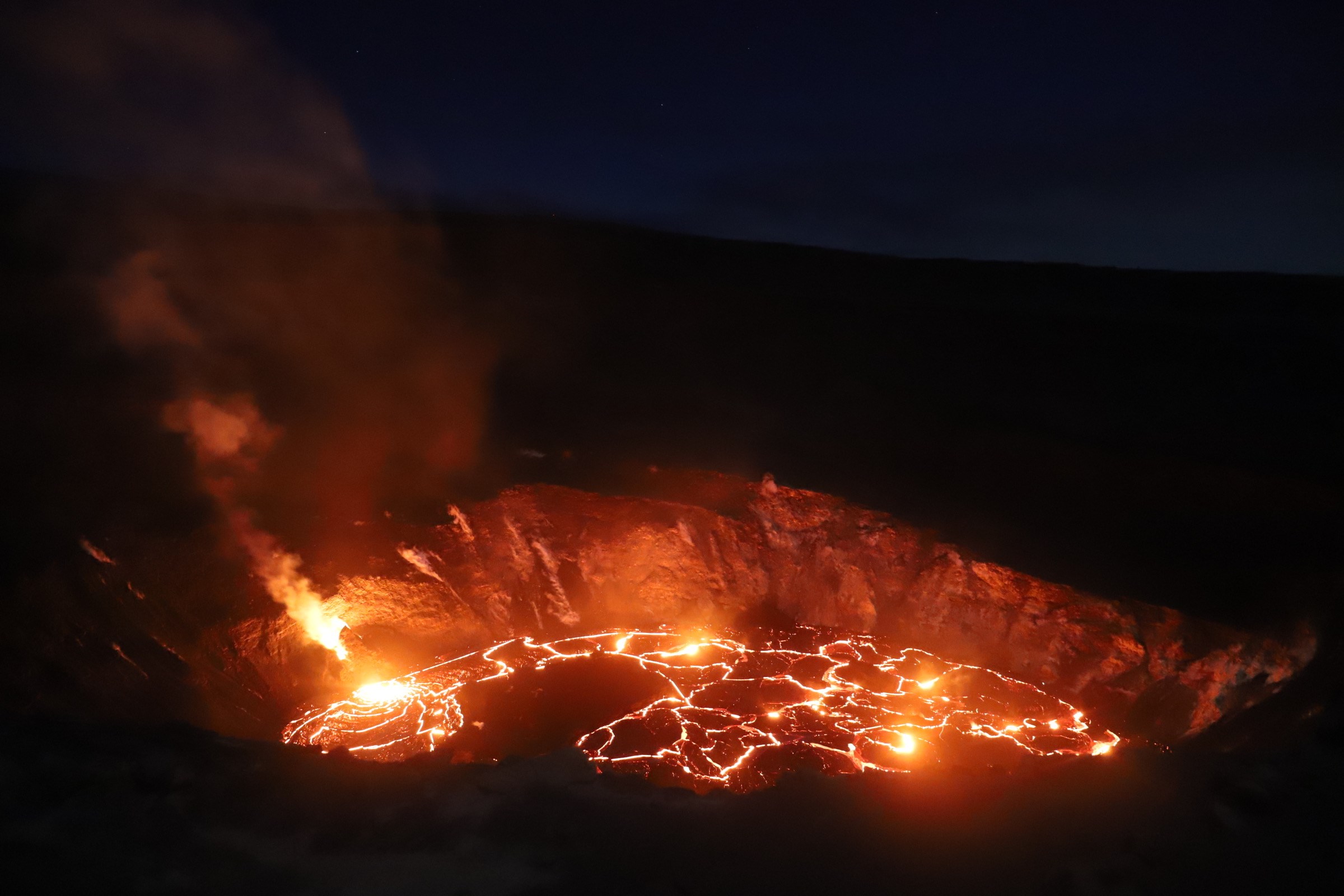
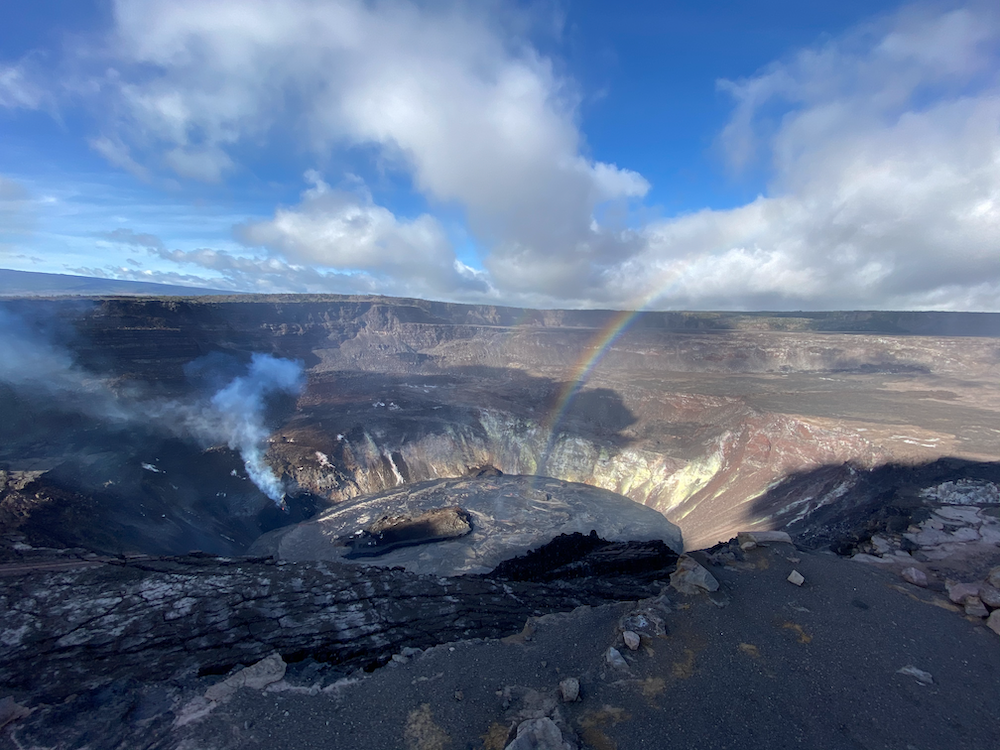
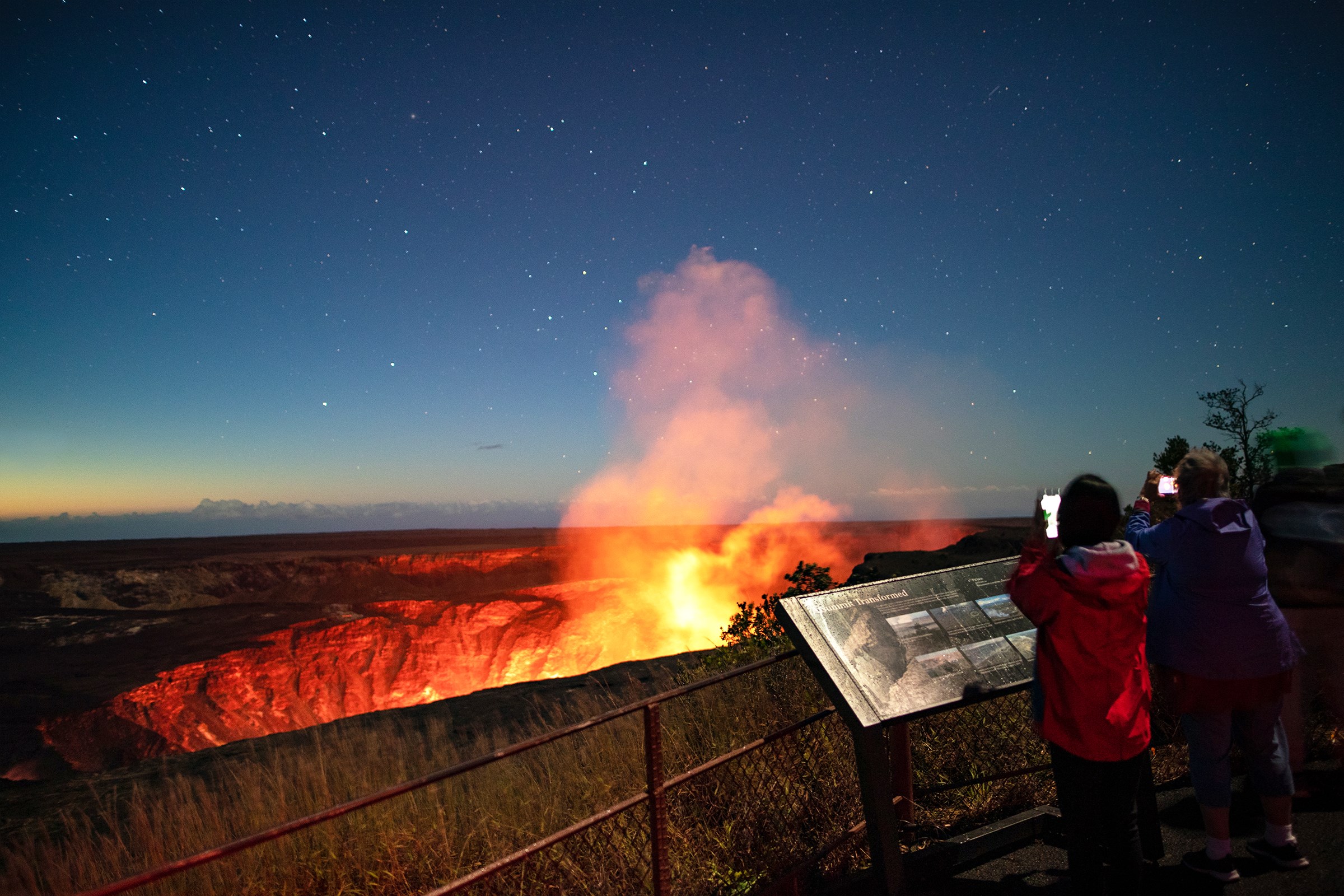
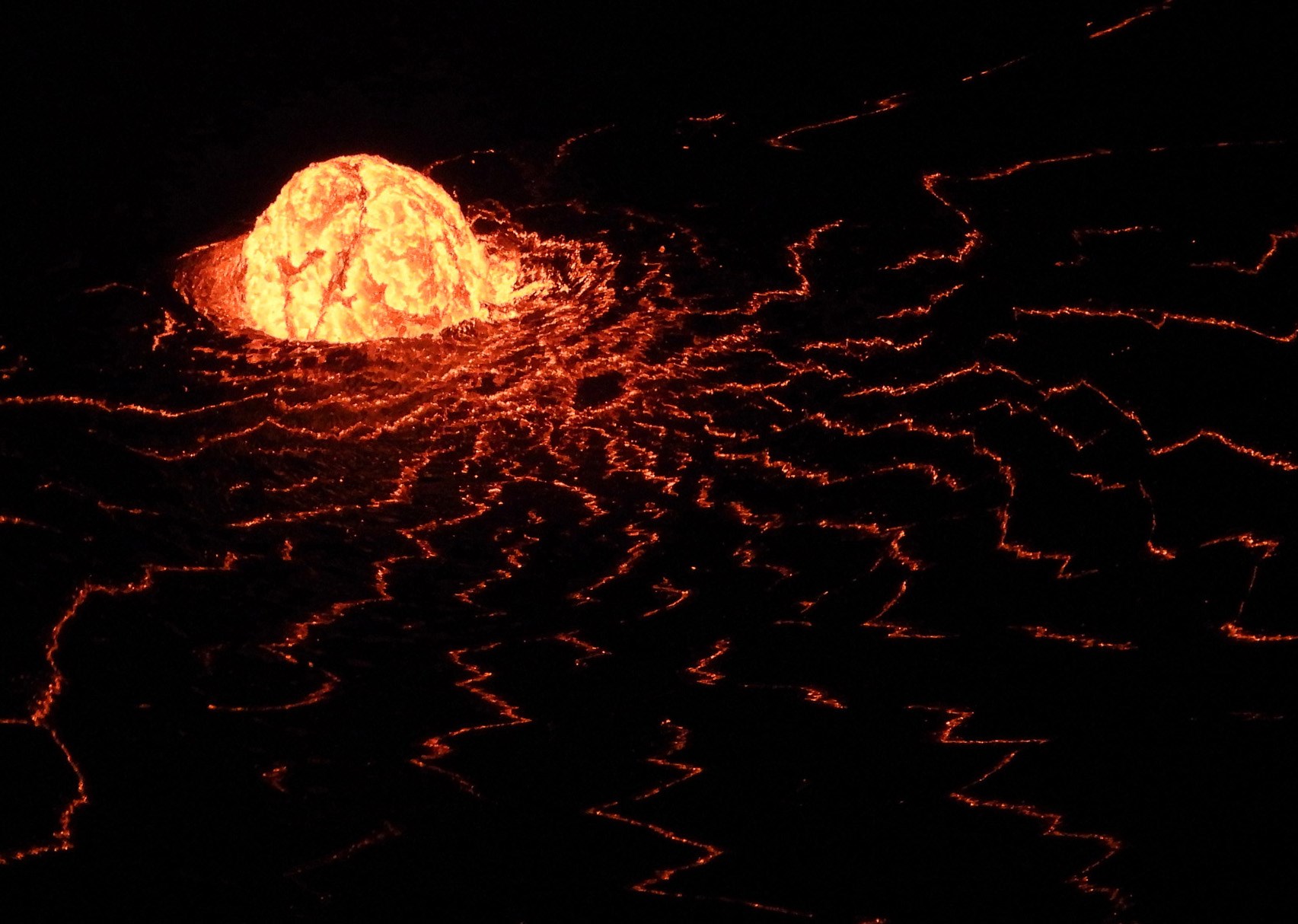
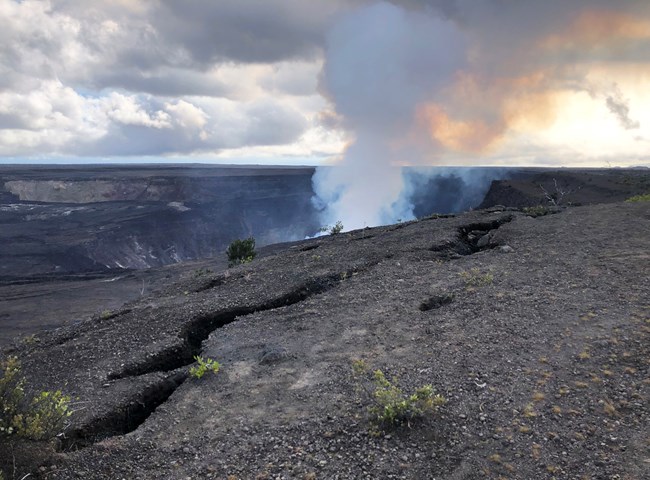
This photo shows just a few of the reasons why it is critical to stay on trails and in designated overlooks if visiting the park to see the current eruption.
Sinkholes, earth cracks, and unstable cliff edges are not always visible, even in daylight. Stay out of closed areas. Some areas still remain unstable after the eruption of 2018, and seismic activity is always a possibility on an active volcano.
spacer
Further reading (Wikipedia)
- “Bizarre ‘ice volcanoes’ erupt on Lake Michigan beach”. Live Science. 19 Feb 2020.
- Nadia Drake (17 Sep 2018). “Dozens of Ice Volcanoes Discovered on Nearby Dwarf Planet”. National Geographic.
spacer
Rare triple ice volcanoes on Lake Superior captured in stunning video
After an unusually mild January, one of Michigan’s wonders was spotted recently on Lake Superior off the north shore of the Keweenaw Peninsula in Michigan’s Upper Peninsula.
A series of videos posted to the PureUP Facebook page shows three ice volcanoes along the shore. Named for its similarity to regular lava volcanoes, ice volcanoes form
when water and slush crush through an ice shelf.
The icy formations are created when weather conditions are just right and become conical in shape as the water freezes after spewing through. Aided by strong wind speeds and subzero temperatures, waves crash through the surface and the volcanoes erupt.
More:Metro Detroit may get up to 8 inches of snow by Tuesday morning
In comparison to other years, the Great Lakes haven’t been shrouded in ice. Only 2.4% of the lakes’ surface was covered by ice on Jan. 24, which is the smallest amount in nearly 50 years, according to the National Oceanic and Atmospheric Administration.
As we approach peak ice coverage season – mid-February and early March – weather experts predict only 30% of the surface will be covered. The amount of ice covering the Lakes during the peak is usually around 53%.
Giant ice volcano erupts in Kazakhstan in video – Strange …
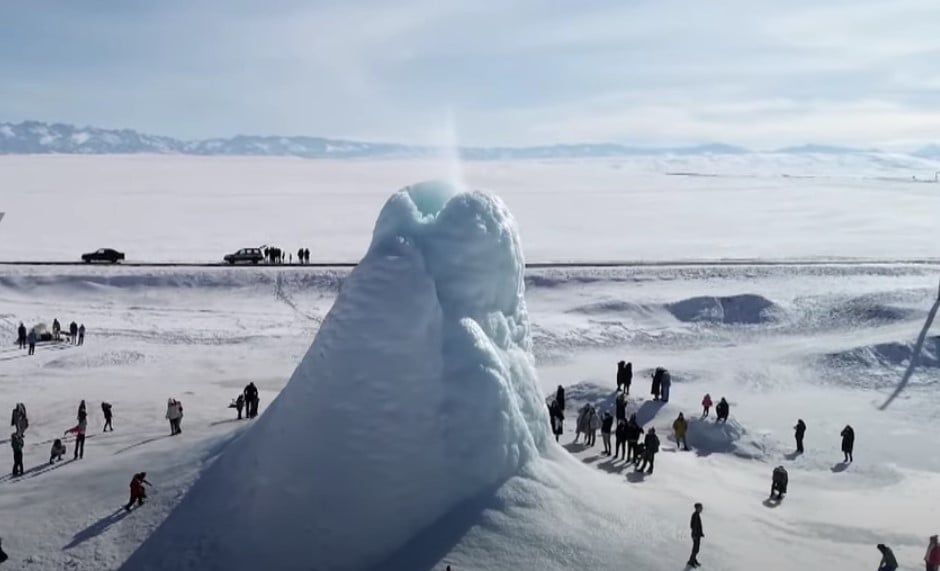
Kazakhstan doesn’t have only animals freezing instantly! Nope! In Kazakhstan’s Almaty region, a stunning ice volcano standing 45 feet tall attracted many thousands of people for its incredible formation.
Despite the thick blanket of snow in the area and the harsh weather, tourists were not stopped to visit the ice volcano formation. The frozen structure was formed from an underground spring that spouted water, freezing it once released.
Although this is not the first time an ice volcano formed in Almaty, as small ice volcanoes also formed last year, locals said that the recent ice volcano in the area is the first to continuously spout water from its top opening that mimics a lava-filled volcano. The continuous water spout has created a small ice rink near its base.
A local shared online that the area is usually covered with greenery during summer, but the iceberg increases to 14 meters and creates a picturesque location during winter.
Kazakhstan: Unusually shapped ice “volcano” grows as cold weather sets
The ice volcano sits between the Kegan and Shrganak villages located about four hours away from Nur-Sultan (formerly Astana), the capital city of Kazakhstan.
A similar natural phenomenon also occurred in the same time last year, in February 2020, wherein a meteorologist near Lake Michigan spotted some ice volcanoes
Ice volcanoes in Kazakhstan are typically found in arcs along the shoreline, but the Almaty region is formed on top of a spring. It is an area that is typically covered with greenery during summer but transforms into an icy land during winter.Ice Volcanoes: Cold Eruption From Below

“Ice Volcano” forms amid freezing weather in New York

 |
 |
| Drilling at Mt. Unzen, Japan was the first successful penetration of a hot conduit at an active volcano. Image from Eichelberger and Uto (2007). | An exploratory well at Krafla volcano in Iceland was infiltrated by magma at a depth of 2.1 km. |

 Image obtained from Metrich et.al 2009
Image obtained from Metrich et.al 2009
| Inducing an eruption through the use of explosives truly seems like science fiction day-dreaming, however, this idea has been discussed since at least World War II. Triggering eruptions by bombing was considered as a means to inflict greater damage on Japan. Although it was never attempted it was certainly discussed, and could therefore be considered a possible engineering solution to an impending eruption in the future. |
 |
 |
| Mt. Rainier looming over Seattle. Photo by Lyn Topinka obtained from USGS. | This cartoon illustrates how a sector collapse, exposing of a pressurized magma body could initiate a lateral eruption. Image obtained from Tulane University. If we could rapidly excavate the overburden and expose the magma we could initiate a planned eruption. |
 |
| If we could plan an eruption at Mt Rainier we could direct the blast to the east and away from high population density areas. In this scenario the preparation and evacuation of several small communities would be easier and much less disruptive than a volcanic crisis situation facing the Seattle metropolitan area. Map obtained from Washington State Search and modified by web designer. Sorry Ellensburg and Quincy. |
 |
 |
| This crater was formed by a shallow, 100 kt nuclear explosion know as Storax Sedan. Calculated as a hemisphere (V=2/3πr3), the volume of material removed from this crater is approximately 0.015 km3. Could we bury several equivalent devices on the eastern flanks of Rainier, or other volcanoes, to expose pressurized magma and trigger and eruption? | For comparison, the debris avalanche that triggered the 1980 eruption of Mt. St. Helens is estimated at ~ 2.3 km3. The eruption is estimated to have released 24 mt of energy. |
Geoengineering And Volcanoes | Earth Wise

Man-Made Volcano to be Created in … – Geoengineering Watch
A new addition to England’s landscape is in the making as scientists are preparing to build a giant balloon in an experiment that seeks to re-create the cooling effect of erupting volcanos.
A new addition to England’s landscape is in the making as scientists are preparing to build a giant balloon in an experiment that seeks to re-create the cooling effect of erupting volcanos.
The experiment will start with scientists attaching large helium filled balloons to 1km of hosepipes, but eventually Engineers from the university of Bristol aim to use balloon the size of Wembley Stadium in an investigation towards the development of climate engineering.
Mount Etna spews lava on the southern Italian island of Sicily August 12, 2011. Mount Etna is Europe’s tallest and most active volcano.
The $2.5 million project called Stratospheric Particle Injection for Climate Engineering (SPICE), is already underway and set to launch next month.
Once the balloons and pipes are put into place at a disused Norfolk airfield, scientists will attempt to pump water up a hose suspended one kilometer off the ground beneath a helium-filled balloon.
According to the scientists light-scattering particles that are pumped high into the atmosphere have a cooling effect on the Earth as they reflect the sun’s rays. They aim to create a similar effect to that of a volcanic eruption which can have an impact on cooling the planet.
The study carried out by the universities of Bristol, Cambridge and Oxford, together with those from Marshall Aerospace has found that Particles of clay, salts or metallic oxides suspended in liquid have more of a cooling effect than sulphates produced by real volcanoes.
The launch that will take place next month is the first of its kind in the UK, and while it is a test run raising the balloon to a height of 1km, engineers hope to raise this to 20km in future experiments.
The method of building artificial volcanoes is seen as a “last resort,” if carbon emissions cannot be taken under control.
‘We are still decades away from doing this and it’s not simply a science decision,” said one of the scientists, Dr. Matt Watson from the University of Bristol speaking at the British Science Festival at. ”There are ethical and governmental decisions around this that are huge. Just because we can do it doesn’t mean that we have the right to do it.”
The pipes are likely to be sited are out to sea. “To pump water to one kilometer you need a pressure of 100 bars. When we start thinking about 20 kilometers we’re talking about 4,000 bar of pressure. You don’t get that kind of pressure at B&Q,” said Dr. Hugh Hunt, from Cambridge University, who will head the Sculthorpe test.
Large volcano eruptions in the past have proved to have a significant impact on decreasing global temperatures. The eruption of Mount Pinatubo in the Philippines in 1991 decreased the earth’s average temperature by 0.5 degrees Celsius over two years.
This was as a result of aerosols reflecting back the sun’s radiation before it reached the atmosphere. SPICE will investigate the effectiveness of stratospheric particle injection, evaluating the best candidate particle and its ideal quantity, delivery method, and likely impacts of the injection.
spacer
Geoengineering: Climate Fixes By Way of a Volcano? – TIME
Geoengineering: A Quick, Clean Fix?

In the course of a long weekend in 1991, the Philippines’ Mount Pinatubo volcano injected enough sulfur dioxide into the stratosphere to temporarily reduce the sunlight reaching the earth’s surface by about 10%. As a result, global temperatures dropped by an average of 0.5 degrees C over the next 18 months. Turns out the lesson nature taught us that weekend has not been wasted; it may help us combat global warming.
The late climate scientist Stephen Schneider used to compare the modern world’s dependence on fossil fuels to a drug addict’s need for heroin. The habit is dangerous and unhealthy, yet almost impossible to break. Certainly, that’s the lesson to be drawn from the inability of the world’s governments to reduce carbon emissions over the past 20 years. So what are we to do? The solution for addiction often involves palliatives like methadone for a heroin junkie, and so it may be for our addiction to fossil fuels. Our planetary methadone, Schneider said, may be geoengineering or the attempt to replicate the effect Mount Pinatubo had on the climate in 1991.
Geoengineering, the deliberate modification of the environment to suit human needs, has long been regarded as the height of hubris by many people and most environmentalists. We are a long way from fully understanding how the climate system works. Who’s to say that in our efforts to tinker with it we won’t make things worse? These are valid concerns, and geoengineering should be approached with caution. But it is increasingly hard to see how we are going to solve global warming without some reliance on it. Indeed, after a lengthy study (in which I participated) the U.S. Government Accountability Office just issued a report about geoengineering that makes this very point.
However hard we try, it will take us decades to make the transition from a carbon-based economy to one powered by new energy technologies. In the meantime, it is possible that global warming may approach a point beyond which there would be no going back. This is where geoengineering comes in: it’s not a long-term solution but a way to keep the earth from overheating while we wait for truly efficient and affordable green-energy technologies to come on line.
Can geoengineering really do the job? The evidence is all around us. Modern global warming is itself evidence of inadvertent geoengineering, the result of all that carbon dioxide and other greenhouse gases we’ve been pumping into the atmosphere for a century or so. But it was the Pinatubo eruption that provided a modern-day example of geoengineering’s potential. Scientists studying the eruption wondered if they could do the same thing deliberately. The eventual result was an ingenious technology known as stratospheric aerosol injection, or SAI, which today is on the verge of providing us with a potentially powerful tool to cool the planet.
Under a plan currently being developed by Nathan Myhrvold’s Intellectual Ventures, sulfur dioxide would be pumped up a 25-km-long pipe suspended by high-altitude balloons, then sprayed out into the stratosphere. Myhrvold, formerly Microsoft’s chief technology officer, says just one such pipe less than a foot in diameter could do the job for the entire northern hemisphere at a cost of less than $1 billion. More research is needed, however, to establish the technology’s ramifications, including its effects on ozone levels.
An even more promising solution is something called marine cloud-whitening. The idea is that if you fill the air with tiny particles around which water vapor can condense, you’ll get denser, whiter clouds that will reflect more solar energy back into space, thus cooling the planet. Together with John Latham of the National Center for Atmospheric Research, the University of Edinburgh’s Stephen Salter has designed a fleet of remote-controlled wind-powered catamarans that would do just that spraying tiny particles of seawater into midocean clouds, brightening them just enough to keep temperatures down.
SAI and marine cloud-whitening are just two of many possible geoengineering projects. Others range from putting giant mirrors in space to planting billions of trees. What they all have in common is the potential to have a large and immediate impact on global temperatures at relatively low cost. None represent any kind of permanent solution to climate change. They are, as many critics have pointed out, merely Band-Aids. But Band-Aids have their uses. The only real solution to global warming is to end our dependency on fossil fuels. Doing this will take time time that geoengineering can give us. We’d be mad not to take it seriously.
Lomborg is the author of The Skeptical Environmentalist and Cool It , head of the Copenhagen Consensus Center and adjunct professor at Copenhagen Business School. His new film, Cool It, opened on Nov. 12
This article originally appeared in the November 22, 2010 issue of TIME Europe.
Our planetary methadone, Schneider said, may be geoengineering or the attempt to replicate the effect Mount Pinatubo had on the climate in 1991. (See Top 10 Famous Volcanoes.) Geoengineering, the deliberate modification of the environment to suit human needs, has long been regarded as the height of hubris by many people and most environmentalists
VolcaNoseR – Exploring volcano plots
Stratospheric aerosol injection – Wikipedia
Volcanic Rock Mechanics: Rock Mechanics and Geo …

Volcanic Rock Mechanics
Rock Mechanics and Geo-engineering in Volcanic Environments
ISBN 9780415584784
Volcanic Rock Mechanics includes papers and special lectures of the 3rd International Workshop on Volcanic Rocks, Rock Mechanics and Geo-Engineering in Volcanic Environments, which was held within the framework of the Congress “Cities on Volcanoes6-Tenerife 2010” (Puerto de la Cruz, Tenerife, Spain, 31 May – 4 June 2010). The book is a comprehensive collection of the most relevant topics related to rock mechanics and geo-engineering in volcanic environments, including:
– Geomechanical characterization of volcanic materials;
– Instabilities in volcanic islands: Slope stability, large landslides and collapse phenomena;
– Geoengineering and infrastructures in volcanic environments;
– Construction materials.
Volcanic Rock Mechanics is of interests to academics, engineers, consultants, designers, contractors and professionals involved in rock mechanics and geo-engineering in volcanic environments.
spacer

NASA – Geoengineering: Why or Why Not?
By: Jim Hodges
History tells of volcanoes that have cooled the earth, of gradual global warming over the past 100 years interrupted by eruptions at Katmai, Alaska, in 1912 and Pinatubo, Phillipines, in 1991 that sent effluence aloft that nearly blocked out the sun.
Image to right: Rutgers professor Alan Robock says that geoengineering should be studied and that he is undecided as to whether its benefits could outweigh its consequences. Credit: NASA/Sean Smith.
Why not inject aerosols into the stratosphere to repeat the effect, slowing the inexorable warming that is melting away the ice at Earth’s poles, among other effects on nature?It’s called geoengineering, and Alan Robock spoke Friday before an overflow crowd at the Science Directorate of the potential benefits and consequences of doing just that.”Freshwater precipitation goes down after a big volcanic eruption,” said Robock, a professor of climatology at Rutgers and a member of the Intergovenmental Panel on Climate Change that shared the 2007 Nobel Peace Prize with former Vice President Al Gore.Simply put, an absent or highly filtered sun inhibits evaporation that forms clouds that bring rain.Robock’s lecture was part of Langley’s “Green Series,” and he called it: “The Science and Politics of Geoengineering? Smoke and Mirrors.”It spoke to both science and politics, and a bit of history.Even further back in time, to the Laki, Iceland, eruption of 1783-84, the effect produced killer droughts in Egypt, based on the Nile River’s levels at Aswan, where records have been kept since 622 AD. There also is anecdotal evidence of droughts in India and China because of Laki.Still, with data piling up of global warming, studies of geoengineering continue, many of them using NASA climate models.”I still haven’t made up my mind,” Robock said as to whether geoengineering is a good or bad idea. “I’ve made up my mind that more study is needed.”But, he added, he began thinking of reasons that would inhibit the concept while at a conference at NASA’s Ames Research Center in November.He has come up with a list of 20, ranging from the moral to the clinical to the technological.For example, geoengineering could have a similar effect to the volcanic eruptions, producing regional climate change that could induce droughts.”And how cold do we want it?” Robock asks rhetorically. “Who decides? Whose hand is on the thermostat?”Possible ozone depletion and increased oceanic acidity could develop. Effects on plants are still unknown, and the possibility of human miscalculation of the desired aerosol quantity to inject into the stratosphere is very real.There are more unknowns than knowns about the process, and one of those unknowns is how to do it in the first place.Beyond that, solar power has been touted as a big piece of a puzzle that could end fossil fuel dependence and clean up the atmosphere. But after injecting aerosols into the stratosphere, “there would be a 20 percent decrease in solar energy,” Robock said.”I guess you could say that any one of those (20) reasons is reason enough not to do it,” he added.Perhaps more personally, though, could the Earth’s inhabitants handle the end of a blue sky?Robock often referred to a reproduction of a classic by Edvard Munch, a Norwegian artist who in 1893 painted a woman in distress under a sky of grays, oranges and yellows. Munch remembered those colors from effluence sent aloft by Krakatoa, which erupted in 1883.The picture is entitled “The Scream.”
spacer

Geoengineering Volcanoes to Rain Death Upon Us
 Foreword by
Foreword by
Marshall Masters
You can only say that geoengineering aerosols (a.k.a. chemtrails) are a tempest in a teapot if you’re a government shill, you’ve never seen a Dane Wigington presentation, or you refuse to look up at the sky. Fifteen years ago when I first took note of geoengineering, 99% of Americans were still “ignorant by choice.”
Thankfully, that percentage is coming down, but sadly, not fast enough. That was my conclusion after being environmentally poisoned by intense geoengineering aerosol spraying in the skies above Yellowstone National Park on September 9, 2015.
This poisoning happened during a cross-country regional reconnaissance from Minnesota through South Dakota, Wyoming, Montana, Idaho, Washington, Oregon, and finally home to Reno, NV.
The purpose of this trip was to spot likely areas for sustainable communities capable of surviving the coming Planet X flyby and to be prepared give those who attend my Relocation Webinars, boots-on-the-ground insights.
Along the way I made a few stops for sightseeing, including Mount Rushmore in the Black Hills of South Dakota and Yellowstone National Park. Little did I realize that these two stops would give me the most valuable intelligence of our trek.
At the hotel near Mount Rushmore I learned a term used by locals to describe the typical visitors to this national shrine: “newly-weds and nearly-deads.” Given my age, I fall more readily into that second category. The term stuck with me, and no matter how insulting it may sound, it perfectly described the bulk of those visiting Mount Rushmore.
During a visit to Yellowstone National Park five days later, I found that this was also a favorite spot for “newly-weds and nearly-deads.” I noted this with a bit of chagrin, but the morning after my visit to Yellowstone I realized that given their relative age and health, “nearly-deads” are geoengineering “canaries in the coal mine.”
While visiting various sites in Yellowstone I noticed a profound shift in how the “nearly deads” were moving and behaving at Yellowstone compared to what I’d seen at Mount Rushmore.
At Mount Rushmore they were limber, moved easily, and happily engaged with each other in pleasant conversation. However, at Yellowstone the “nearly deads” lumbered with difficulty. They seemed dazed, stiff, and detached, and hardly spoke to one another. In fact, even the “newly weds” seemed somewhat similarly affected as well―but from what? That’s when I looked up.
As I stated in my Cut to the Chase interview, Denial Be Damned — Geoengineering Activist, Dane Wigington, I’ve been following the topic of geoengineering since 1999. Over the years I watched the spraying over different skies, but on that day in Yellowstone what I saw was stunning. It was like nothing I’d ever seen before. The spraying was so thick it was creating a solid, soupy cover and wherever the cover parted, another jet would appear to spray it closed again.
I traveled the park extensively and no matter where we stopped, the spraying was thick and continuous.
That puzzled me, but in retrospect I should have been more alert to what I was seeing, and that lack of attention cost me dearly.
Midway through the park I visited Mammoth Hot Springs and I wanted to capture some video of the springs for my forthcoming Pole Shift docuseries, due out this fall. I was there for about the same time as the others, who were mostly “newly weds.” Interestingly enough, the “nearly deads” never got as close to the bubbling springs, nor stayed as long as I did.
That makes sense as there are ample warnings that if you begin to feel nauseous or ill while viewing any of the Yellowstone thermal features, to immediately step away. I never felt nauseous at Mammoth Hot Springs as I shot my video. However, during our drive away from the park I began to feel weak and disoriented. I developed a severe headache that was impervious to a strong dose of over-the-counter pain medication, and my body began to ache all over as well.
That evening I stayed with Richard Shafsky. I interviewed Richard on Cut to the Chase back in July of 2015, The Mayan Crystal Skull and Planet X – Richard Shafsky, and we’ve stayed in touch ever since.
Once we arrived I told Richard how I was feeling. He said I had likely been poisoned by geoengineering aerosol spraying at the park, but that I’d know for sure in the morning. Ugh… The morning was awful. It was like a flu from hell with an intense headache that started at the top of my head and ran down every ligament, muscle, and bone in my body, all the way down to my toenails.
While nursing a non-stop stream of coffee refills that morning, I explained all of my symptoms to Richard. He listened attentively and asked a few confirming questions, then he told me it appeared that I had been environmentally poisoned at Mammoth Hot Springs. I knew well enough to take that seriously because Richard is a self-taught organo-metallic chemist who worked in the mining, refining, water purification and hard rock industry.
“Now I understood why all the “nearly deads” at Yellowstone National Park (myself included) were moving like dazed, sullen tin men in need of a good oiling that day.”
But why Mammoth Hot Springs? and how could Richard be so specific about where I was poisoned? I asked him to explain, and what he told me is that in addition to spraying us with barium, strontium, and aluminum, geoengineers have now added sulfur compounds to the mix. Ergo, the sulfur compounds they were spraying from the air combined with the sulfur bubbling out of Mammoth Hot Springs to form the toxic brew that had poisoned me. Now I understood why all the “nearly deads” at Yellowstone National Park (myself included) were moving like dazed, sullen tin men in need of a good oiling that day.
It was then Richard began to explain this new program of spraying geoengineering aerosols heavily above the :Yellowstone super-volcano.
It took 24 hours for my body aches to go away, but another two days for the rest of the symptoms to go away. Unfortunately for me, this poisoning made me more susceptible to yet another environmental poisoning. After reaching the hotel in Ontario, Oregon for the final journey of the night, I smelled the unpleasant odor of petrochemicals in the air from a nearby petroleum refinery plant.
It reminded me of what I saw and smelled as I drove through Billings, Montana. Three such petroleum refinery plants that make one sorry for the residents in the area who could not sell their devalued homes and how they must suffer from living there and breathing the fumes day-in and day-out.
I also realized that in addition to the many low rivers and lakes, and the stressed, dead or dying trees we saw along the way, that we had seen more American flags painted onto the sides of the large chemical plants we passed than on all the tee-shirts we saw tourists wearing at Mt. Rushmore and Yellowstone.
When I settled in for the last night of our trip in Ontario, Oregon the chemical smell was barely noticeable in the room, but by four a.m. I awoke with an irritated and constricted throat that was rather uncomfortable, and the chemical smell was intense. It was clearly an allergic reaction and getting out of the hotel early and back on the road, along with a strong dose of antihistamine, relieved me of the throat constriction. After returning to Reno it took me several days to fully recover from both of these environmental poisonings.
What should have been a joyful trip filled with amazing sights became a sad and dreary business with terrible health consequences. But what I remember most was not all of this. It was what I saw and heard when I talked to people along the way: farmers, ranchers, truck stop clerks, waitresses, late night hotel clerks, folks at rest stops, and so forth.
While they all came from different places and different walks of life, they all had one thing in common. None of them were dismissive about what the fact that our Earth is sick and it is getting worse. None of them were in denial about it. No one said this was just a bad year and next year would be better. No more dismissive bravado. Just a sad knowing that things are getting worse and will continue to do so—that there will be more record droughts, record fire seasons, and record misery in the Great American West.
Bottom line. We are presently in the Holocene extinction also known as the Sixth extinction event. The difference between this event and all prior extinction events is a target species. We are that species.
What do we do about it? Whatever we can. In his article, Richard Shafsky explains our physical reactions to geoengineering aerosol spraying and how we can mind our health. After reading his technical explanation of what is being done to us, I suggest you view the helpful supplementation protocols he has listed on his web site: richardsremedies.com.
―Marshall Masters
Geoengineering Volcanoes to Rain Death Upon Us
By Richard Shafsky
Why would geoengineers go to the effort to move the jet stream so that it bypasses the Pacific West entirely and comes down over the Yellowstone area, knowing that by doing so they are drying out and sacrificing some of the most productive agricultural areas in the country? Why are geoengineers spraying aerosols more heavily above Yellowstone National Park than in any other area of the country?
The activity of the Yellowstone “super volcano” and the impact it has on the atmosphere and weather patterns answers this mystery.
This also ties into the volcanic ion highway of the Cascade Mountains, which are also being heavily aerosolized with geoengineering sprays. These sprays are then being carried high into the upper atmosphere of the jet stream by the ionic vortexes that are continually active above these volcanic areas. The action of these ionic vortexes is a force-multiplier for geoengineering like no other.
The volcanoes Lassen, Rainier, St. Helens, and Shasta that form the Cascades collectively produce an entire chain of ionic vortexes. If one views a map of the drought and fires that are currently plaguing the Pacific Northwest you can see that they coincide neatly with the areas that have been artificially desiccated, or dried out, by geoengineering aerosols.
Climate Change
The primary climate change factor is geoengineering in all its facets. “Man-made global warming,” now called “climate change,” is based in political science, not in pure science. However, if one comprehends the extensive geoengineering that is being perpetrated on our Earth, and has been for many years, then one can assuredly say that, “yes, climate change IS man-made.”
Deep Below
The axiom, “as above, so below,” applies to our understanding what is going on in the area known as the Yellowstone Caldera, which is part of Yellowstone National Park.
Below the caldera surface, at a depth of 6-12 kilometers (3 ¾ – 7 ½ miles), is molten magma at temperatures of 1800 degrees Fahrenheit or more. It is perhaps the most para-magnetically charged basalt in North America, meaning the magnetic charge is both positive and negative at the same time.
This occurs when the 1800°F+ water has turned into “live steam,” which separates the hydrogen and oxygen molecules from H2O (water is made of two hydrogen molecules and one oxygen molecule) and transfers the charges from these now divided molecules into the lava.
It no longer is water (H2O), but it still retains its magnetic properties. This live steam is energized, or ionized, by the splitting of the water molecules into separate elements and the transfer of the charge. This energy creates movement.
Creating a Vortex Spin
Since the caldera is an active volcano the entire area above ground is also a very highly ionized and charged zone both magnetically and electrically.
This ionized zone forms a very powerful and complex vortex, or spin. The ionization process underground continues as gasses are released above ground. This ionized high-temperature-driven vortex rising above the caldera interacts with our atmosphere becoming an ion flow.
The atmospheric mix over the Yellowstone Caldera includes ionized sulfur, hydrogen, and oxygen compounds seen as steam, vapor, and water. This is seen and smelled in the continuous venting, vapors, and geysers, adding a great deal of both thermal and ionic energy to the vortex spin.
These ionic flows interact with the magnetically ionized gases in our atmosphere of nitrogen, oxygen, hydrogen, and carbon dioxide. Within the charged vortex there is a maelstrom of activity that creates “static noise” which is silent to humans but can be identified and measured with standard radio equipment.
This magnetically electrically ionized vortex, when in contact with our natural atmosphere, can produce magnificent lightning storms and water-filled thunderclouds. The rim of the nearly 3,500 square mile Yellowstone Caldera, is mountainous and is host to the natural precursors to thundercloud formation: positively and negatively charged (or ionized) oxygen and hydrogen.
Thunderstorms are formed of magnetically and electrically ionized layers of primarily oxygen and hydrogen. The ionization provides the energy that creates the air movement and the lightning, and Yellowstone Caldera has a lot of ionization! This explains the “mountain weather” experienced in the area to some extent.
All natural atmospheric gases each have their own signature frequencies, wavelengths, and harmonics, all of which are in balance with life on Earth. These harmonics are similar to an orchestra where every musician is playing together in correct time, harmoniously. This harmonious orchestra represents the kind of harmonic energy which is good for the body. However, adding unnatural and toxic geoengineering aerosols can create harmonic energy that is bad for the body, as if all of the musicians were playing out of time with each other and discordantly.
Sulfur
The skies above the active Yellowstone caldera “super volcano” are routinely being geoengineered with aerosols of soft and heavy metals such as barium, strontium, and aluminum along with other organo-metallic compounds and manufactured polymers. A newly discovered additive is now sulfur compounds.
Carbon dioxide (CO2) which is essential for life, is displaced by sulfur dioxide (SO2). CO2 supports all life (trees and plants use it for fuel, then generate oxygen); SO2 depletes all life because sulfur dioxide is an oxygen scavenger. Without adequate oxygen an organism will die.
For example, there are sulfur-dioxide-containing sticks which can be purchased at hardware stores for eliminating pests like prairie dogs or gophers. The stick is lighted, placed in the entrance to the animal’s den, the hole is covered up, and the sulfur dioxide is released into the air in the den as the stick burns. The sulfur dioxide displaces all the oxygen, and the animals in the den die.
Obviously we do not want to breathe air which has had sulfur dioxide added into it, since it is harmful to all forms of life which depend on oxygen. Additionally, water which has had sulfur added to is is not useable by plant life, which does not recognize it as water. A farmer would never add sulfur to water and then irrigate a crop with that water. The crop would fail.
With all the increased volcanic activity that is occurring globally both above ground and under the seas, we are witnessing an increase in the acidification (as in sulfuric acid) of the ocean and atmosphere. The acidification and temperature increases are taking place at the ocean bottom at the volcanic vents. Deep water ocean temperatures increase from volcanic heat sources being released at the bottom of the ocean. Ocean temperatures are not increased atmospherically from the air above the ocean.
Using the Flow
The ionized toxins being sprayed over Yellowstone become a part of the ionized vortex and are lifted high up into the atmosphere where they will be distributed everywhere the jet stream goes. This ionization additionally facilitates the manipulation of the position of the jet stream with HAARP harmonics.
Geologically, this is because the Yellowstone area is located in a sulfide zone which increases the energy of the ionic vortex. The increase is akin to going from the power of a firecracker to the power of a stick of dynamite. How does that happen? The sulfur is highly charged, and that ionic charge is transferred to the water, steam, and air in the area. This creates increased kinetic and other forms of energy in the ionic vortex.
The caldera vortex, being thrust up as well as drawn up as an ionic flow into the atmosphere, is being used to feed naturally-occurring ionized toxins into the jet stream and ionosphere where they become bonded to the toxic components of the geoengineering aerosol spray. No doubt other volcanic calderas that have ionic vortexes are being utilized to manipulate and distribute toxic aerosols ionically into the jet stream.
Adding Radiation Into the Mix
Unfortunately when we combine the ionized radiation being continuously released from the Fukushima reactor in Japan with the ionized metallic substances of the geoengineering aerosols, highly toxic radiated alloys are being created in our atmosphere.
Most of the geoengineering spraying is deliberately carried out during the daylight hours because of the ionizing aspects of photons from the sun on geoengineering aerosols. Conversions are taking place on an ionic level which can be measured as background radiation. Any radiation readings that are above the normal of 25-30 “counts per minute” or CPM’s, are the result of man-made distributed radiation.
Two major air currents, the Japanese current that comes across the Pacific, and the jet stream over North America, have both been radiated. As these radioactive air currents hit our continent they are bonding with the toxic geoengineering aerosols. This results in radioactive metals and other radioactive components in our atmosphere. This can be confirmed by reading the rad counts (CPM’s) across the country. While any CPM over 50 is cause for concern, it is no longer uncommon to see counts of 500 or above in cities in the United States!
Physical Reactions
Many visitors touring the Yellowstone Caldera experience subtle physical reactions. Yellowstone’s natural off-gassing in the concentrations and exposures that most tourists get are not harmful. However, aerosolized desiccants (geoengineering sprays) combined with the naturally-occurring sulfur gasses dehydrate both animals, humans and the terrain itself, and scavenge oxygen from living bodies. Add in the brain toxins of ionized aluminum and ionized barium with oxygen deprivation from sulfur dioxide, and you can easily experience temporary short-term memory loss and become tipsy, not unlike when drinking alcohol.
Other reactions may include sore throat, stinging dry eyes, respiratory distress, runny and/or bloody nose, headache, joint and connective tissue pain, along with impatience, irritability and fatigue. The equilibrium wobbliness is caused by lowered oxygen levels from the sulfur dioxide that is venting from the thermal features at Yellowstone, as well as coming in from the desiccating geoengineering aerosols and the high altitude of the Park.
When our human physiology is bombarded with harmonics detrimental to the body and toxic ionized metallic elements that are designed to alter, deplete, desiccate, and corrode water systems, our bodies are physically in jeopardy!
Minding Our Health
What can we do to help counteract and balance the physical degradation that takes place with these harmful exposures? I recommend taking daily supplements of iodine that is approved for internal use, daily turmeric, homeopathic remedies for detoxification, and to drink plenty of clean, unadulterated water.
Be aware of your exposures to the geoengineering aerosols (the amount of time you spend outdoors when geoengineering aerosols are visible), your exposure to the sun (UVB is prevalent now rather than balanced with UVA), and use commonsense approaches to mitigate your exposures, as outlined on my web site: richardsremedies.com.
Geoengineering vs. volcanic activity for a cooler climate …
Geoengineering:The Radical Solution Tucked Into the House Democrats’ New Climate Plan
Does geoengineering have a place in our policy toolbox?
The House Democrats’ new climate plan includes a call for research into the controversial idea of geoengineering, large-scale attempts to manipulate the Earth’s atmosphere and cool the planet down. / Gary Hershorn/Getty Images
If the COVID-19 disaster has demonstrated one thing, it’s the terrible human toll of not following the science. Had the advice of U.S. public health experts been followed and mask-wearing and social distancing been required early in the pandemic, tens of thousands of lives would likely have been saved.
But one of the not-often-discussed consequences of following the science is that you never know where it will take you.
Consider the House Democrats’ just-released climate plan.
It’s a smart, ambitious, transformative roadmap to managing the climate crisis and using it to build a better world. David Roberts at Vox has a good rundown of the plan and the politics behind it. Leah Stokes, a professor of political science at the University of California, Santa Barbara, and author of Short Circuiting Policy, has a great thread on the plan’s policy nuances.
But buried on page 535 of the plan is what amounts to a call for a federal geoengineering research program:
“Atmospheric Climate Intervention,” a.k.a. geoengineering, is the Frankenstein of climate crisis solutions, the inhuman beast that no one can quite kill. In case you haven’t heard the term before, geoengineering refers to large-scale attempts to manipulate the planet to reduce the risks of climate change (you can read more about it in my book How to Cool the Planet: Geoengineering and the Audacious Quest to Fix Earth’s Climate).
Geo–Engineering.org GmbH, your partner for geophysics …
Our Company | GeoEngineers
spacer
Volcanic eruptions can reduce water flows in big rivers, according to a new study that cautions against schemes to fight global warming by injecting reflective particles into the sky.
In the first study of its kind, University of Edinburgh scientists Dr Carley Iles and Professor Gabriele Hegerl compared annual water flow in 50 rivers around the world with the timing of major volcanic eruptions, notably Agug in 1963, El Chichon in 1982 and Pinatubo in 1991.
For some rivers, records went back into the 19th century, making it possible to take into account earlier eruptions too.
They discovered that a year or two after these volcanoes belched massive amounts of debris into the upper atmosphere creating a partial sunscreen, the flows of tropical rivers decreased.
“It was known that volcanic eruptions affect global rainfall,” Dr Iles said.
Less sunlight means less evaporation, while cooler surface temperatures diminish the capacity of the atmosphere to retain water.
“But it was previously unclear to what extent this translated into changes in river flow,” she added.
The study does not specify by how much water volume was reduced, but a rough calculation for the Nile and the Amazon — the world’s largest river by discharge — showed a drop of about 10 per cent.
That may be enough to have an impact on agriculture and the wellbeing of humans that depend on those rivers, especially if highly populated regions, she suggested.
Globally, the net impact of big eruptions has been a drop in water flows. But in some regions — southern South America and the south-western United States — the amount of water coursing through rivers increased.
The differing results, Dr Iles explained, stemmed from variations in regional weather patterns.
Caution against geo-engineering as climate change solution
The study, published in Nature Geoscience, also cautioned against so-called geo-engineering schemes proposed as a solution for cooling down an overheating planet.
“As well as affecting river flow and rainfall, volcanic eruptions have a cooling effect on climate,” Dr Iles said.
“All of these impacts come about because volcanoes inject particles — sulfate aerosols — high up into the atmosphere, and these spread out and reflect sunlight back out into space.”
The eruption of Pinatubo, for example, discharged 17 million tonnes of sulphur dioxide 40 kilometres into the lower stratosphere where it lingered for several years, eventually dissipating.
Advocates of “radiation management” have proposed injecting massive quantities of similar particles, with cannons, planes or giant tubes, high into the sky to achieve the same effect.
“Our findings suggest that these kinds of geo-engineering schemes are likely to have side effects on river flow, so caution is advised,” Dr Iles said.
AFP
U.K. Researchers to Test “Artificial Volcano” for Geoengineering the Climate
An experiment starting next month in the U.K. will pump water one kilometer into the air to test a new climate-cooling method that eventually could deliver sunlight-reflective sulfate particles into the stratosphere
By Sarah Fecht on
The experiment is the first major test of a piping system that could one day spew sulfate particles into the stratosphere at an altitude of 20 kilometers, supported by a stadium-size hydrogen balloon. The goal is geoengineering, or the “deliberate, large-scale manipulation of the planetary environment” in the words of the Royal Society of London, which provides scientific advice to policymakers. In this case, researchers are attempting to re-create the effects of volcanic eruptions to artificially cool Earth.
The $30,000 test, part of a project called Stratospheric Particle Injection for Climate Engineering (SPICE), is inspired by the 1991 eruption of Mount Pinatubo in the Philippines. That volcano spewed 20 million tons of sulfate particles into the atmosphere, cooling Earth by 0.5 degree Celsius for 18 months. If the British feasibility tests are successful, the balloon-and-hose contraption could be used to inject additional particles into the stratosphere, thereby reflecting more of the sun’s energy back into space, and hopefully curbing some of the effects of global warming.
“This is one of the first times that people have taken geoengineering out of the lab and into the field,” lead scientist Matthew Watson said Tuesday during a press conference in London. “We are still decades away—and I do mean decades—from doing real geoengineering.” Watson said his team still needs to determine which substances would work best at reflecting light, how much is needed to have an effect, and the possible unintended consequences of injecting the particles into the atmosphere, such as acid rain, ozone depletion or weather pattern disruption.
October’s tests will mainly focus on whether the balloon-and-hose design could be an effective method to deliver the sunlight-reflecting particles. At an airfield in Norfolk, England, that is no longer in use, a helium blimp will hoist a regular pressure-washer hose one kilometer off the ground. An off-the-shelf pressure washer will pump up 1.8 liters of tap water per minute, to a maximum of 190 liters, says Hunt, which will evaporate or fall down to the ground locally. The researchers will monitor the performance of the system, and use the data to design the larger 20-kilometer-high setup.
In the past scientists have proposed similar atmospheric delivery methods using guns, airplanes, rockets and chimneys. In 2009 Russian scientists even tested airplane delivery on a small scale. But Hugh Hunt, a SPICE engineer at the University of Cambridge, said the balloon-and-hose design appears to be the most cost-effective option. Even when scaled up, the team expects the simple design to cost around $5 billion, in comparison with the $100 billion needed to launch thousands of high-altitude aircraft.
The water tests are expected to be harmless, but several environmental groups have criticized the plan—and geoengineering in general. Last year, the United Nation’s Convention on Biological Diversity issued a statement forbidding geoengineering research that may impact biodiversity. The U.K. accepted that statement, but the SPICE experiment does not violate any international agreements due to its small scale, says Jason Blackstock, a physicist at Canada’s Center for International Governance Innovation.
Nevertheless, the Canada-based Action Group on Erosion, Technology and Concentration (ETC) is calling the tests internationally irresponsible. In a written statement, they called on the British government to shut down the project, adding: “This experiment is only phase one of a much bigger plan that could have devastating consequences, including large changes in weather patterns such as deadly droughts.”
Alan Robock, a Rutgers University meteorologist, shares some of those concerns. He has created computer simulations indicating that sulfate clouds could potentially weaken the Asian and African summer monsoons, reducing rain that irrigates the food crops of billions of people. It is premature to conduct such field experiments, Robock says. More computer modeling should be done first, he adds, to determine how injected particles might interact with the ozone layer and the hydrologic cycle.
Whereas Hunt agrees that such research is lacking, he said that the team needs real measurements in order to see if the tethered balloon design is viable. “If not now, then when would you start?” he asks. “This year, next year? Or maybe wait until a large block of ice falls off of Greenland? My choice is to have all the tools carefully thought through, so that we don’t have to rush into anything.”
To avoid dangerous climate change, some scientists estimate that global CO2 emissions must be cut by at least 80 percent by the end of the century. Geoengineering will not help achieve that long-term target, but the cooling effects of large sulfate clouds are nearly instantaneous, making geoengineering potentially valuable in the event of acute climate crises such as the melting of Arctic sea ice, which could further accelerate global warming over the decades.
The researchers made it clear in Tuesday’s press conference that they do not advocate using geoengineering as an excuse for humanity to continue recklessly emitting carbon dioxide and other greenhouse gases. “[Geoengineering] should be considered as an emergency remediation while we wean ourselves off carbon,” Watson said. “The question you have to ask is, is it worse without mitigation or with it? And that answer isn’t obvious yet.”
Engineering on an Active Volcano – GEOetc


Link: https://www.sciencedirect.com/science/article/pii/B9780123859389000754
Volcano tourism is growing in popularity as more people are interested in exploring unique natural areas and at the same time study the geologic heritage. Protected sites such as national parks, geoparks, and World Heritage sites play an important role in volcano tourism and present visitors with an opportunity to learn about geodiversity in close contact to nature while experiencing scenic beauty. With over 1500 active volcanoes worldwide, for many regions volcano tourism represents a welcome economic advantage. Active and dormant volcanic attractions therefore provide a valuable natural resource for tourism including geotourism, adventure tourism, and ecotourism. Often the aftermath of a violent eruption will bring increased numbers of visitors, which links volcano tourism frequently to disaster tourism or dark tourism with Pompeii, a popular example of World Heritage site, which is based on the devastation caused by a volcanic eruption nearly 2000 years ago.
Volcano 2021: Best of Volcano, HI Tourism – Tripadvisor
spacer

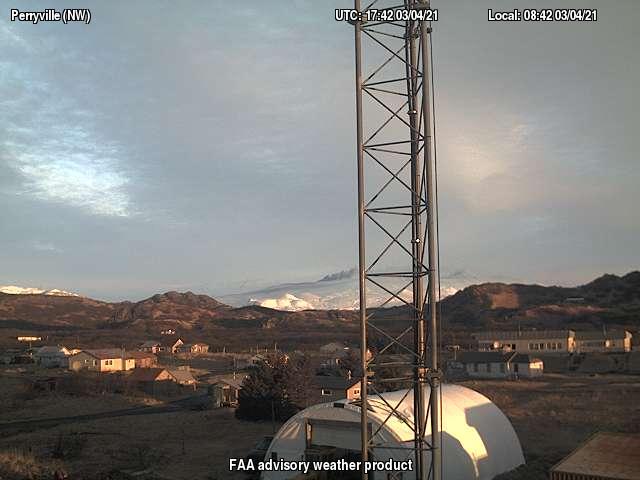
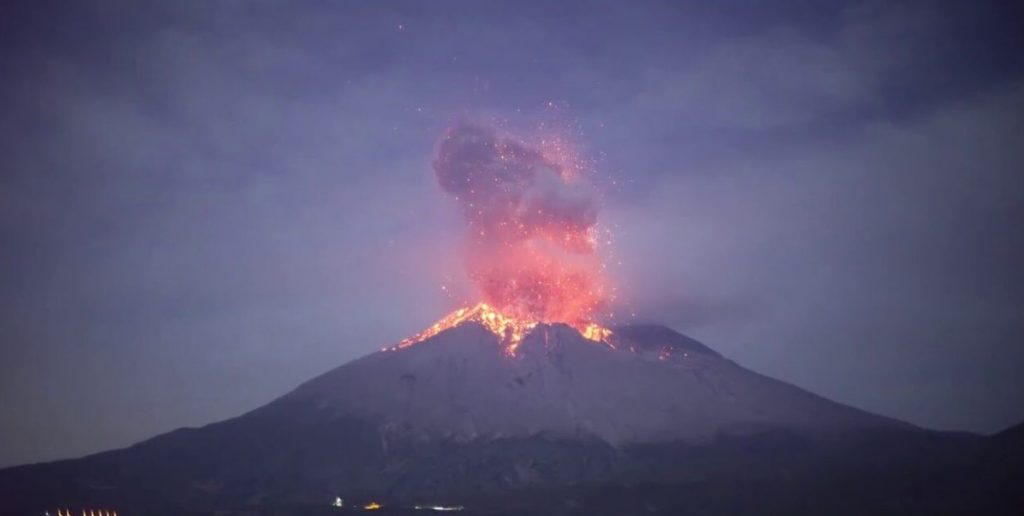
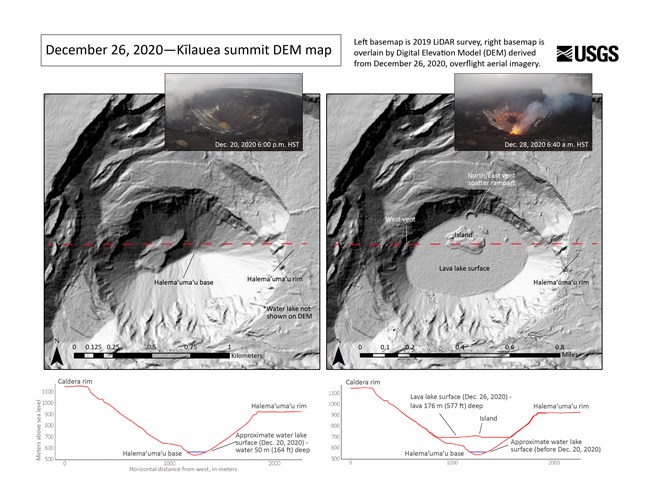





 Image to right: Rutgers professor Alan Robock says that geoengineering should be studied and that he is undecided as to whether its benefits could outweigh its consequences. Credit: NASA/Sean Smith.
Image to right: Rutgers professor Alan Robock says that geoengineering should be studied and that he is undecided as to whether its benefits could outweigh its consequences. Credit: NASA/Sean Smith.



















